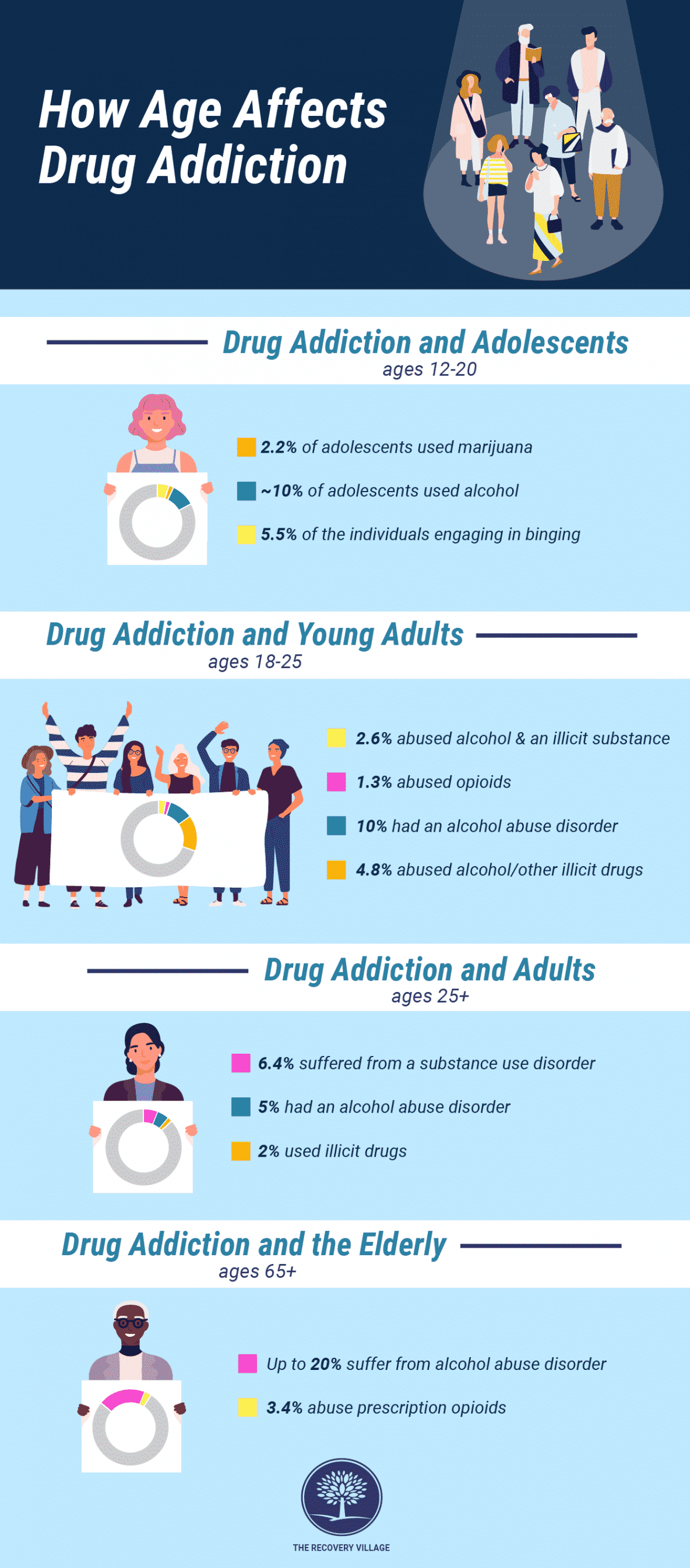Age is an important aspect that influences the vulnerability of an individual to substance abuse. Learn what factors lead people to abuse substances at different periods of their life.
A variety of factors influence the vulnerability of an individual todrug addiction. These factors include the environment of an individual, their personality, education levels, and familial bonds. Age also plays an important role in determining the susceptibility of an individual to addiction, as well as the kind of drugs the individual is likely to use.
Relationship Between Age and Drug Addiction
Drug addiction typically begins at a young age, with higher rates of addiction seen in adolescents and young adults. However, drug addiction stemming from the use ofprescription drugshas become more prevalent in adults and the elderly. The age of onset of drug use tends to determine the type of substance abused, with early-onset of substance use characterized by a higher likelihood of illicit substance use.
Drug Addiction and Adults
Individuals with substance abuse disorder over the age of 25 may be classified as belonging to either early-onset drug users or late-onset drug users. Individuals in the early-onset group initiate smoking, alcohol and marijuana use before 20 years of age and are likelier to be addicted to illicit drugs. Individuals in the late-onset group generally do not use these drugs before reaching 20 years of age and are likelier to abuse prescription medications. The 2017 NSDUH annual report found that:
- Among adults 26 years or older (including the elderly), 6.4% of individuals suffered from a substance use disorder
- 5% of adults in this group had an alcohol abuse disorder whereas only 0.8% used marijuana
- 2% of individuals in this group used illicit drugs with 0.7% using opioids
- 0.6% of this group used more than one substance
- About 1.6% of individuals had aco-occurring substance use disorderand serious mental health disorder
Drug Addiction and Adolescents
Adolescence is the most likely time of a person’s life that they develop an addiction. Cigarettes, alcohol, andmarijuanaare the most commonly abused substances in this age group. About 20% of individuals between the ages of 12 and 20 in the United States consumed alcohol at least once in 2017.
New Year, New Beginnings.
Whether you are struggling with addiction, mental health or both, our expert team is here to guide you every step of the way. Don’t wait— reach out today to take the first step toward taking control of your life.

Adolescents who have beensubjected to interpersonalviolence, including physical and sexual violence, tend to be at a higher risk of substance abuse. Substance abuse disorder in adolescents is also comorbid with other psychiatric disorders, includinganxiety disorders,bipolar disorder, andpost-traumatic stress disorder.
Drug use by a family member is another factor correlated with the likelihood of substance abuse in adolescents. Peer pressure also plays a significant role in substance abuse, and a strained relationship with parents increases susceptibility to peer pressure and substance use. The 2017 National Survey of Drug Use and Health (NSDUH)annual reportfound that:
- About 4% of adolescents suffer from a substance use disorder
- 2.2% ofadolescents used marijuana
- Almost 10% of adolescents used alcohol in the month before the survey with 5.5% of the individuals engaging in binging, and 1.8% of adolescents had analcohol abusedisorder
- 0.4% of adolescents had an opioid use disorder
- 1.4% of adolescents with a substance use disorder had amajor depressive episodein the past year
Related Topic:Substance abuse treatment for teens
Drug Addiction and Young Adults
Drug addiction is common in young adults, with individuals between the ages of 18 and 25 likelier to have used drugs in the previous month and year relative to older adults. The tendency for substance abuse in young adults is associated with trying to cope with the increasing challenges and responsibilities that come with adulthood. These challenges include leaving home for work or education and establishing new social relationships.
Young adults are also prone to be exposed to alcohol and other substances through their social environment. As in adolescents, family factors and peer use are predictive of the risk of substance abuse. The 2017 NSDUH annual report showed that:
- 14.8% of adults between the ages of 18 and 25 abused alcohol or other illicit drugs
- 10% of this group had an alcohol abuse disorder, followed by 5.2% who used marijuana
- 1.3% of adults ages 18 to 25abused opioids
- 2.6% abused both alcohol and an illicit substance.
- 1.8% of individuals in this age group had a serious mental illness co-occurring with a substance use disorder
Drug Addiction and the Elderly
Although previously considered as an age group with lower substance abuse rates, recent studies suggest an increase in the rate of substance abuse in the elderly. Alcohol abuse is the most common form of abuse in this group. The use of prescription drugs has also grown in the elderly, with almost 37% of the population over 65 years of age using more than five prescription drugs. Prolonged use of these drugs may lead to dependency. Commonly abused prescription drugs among this population include opioidpainkillersand sedatives likebenzodiazepines.
Elderly individuals with drug abuse problems may also be classified as early-onset abusers or as late-onset substance abusers. Early-onset users are those who started using drugs or alcohol before age 65 and continue to do so later in life. Late-onset substance abuse may develop as a way to cope with the death of a spouse, retirement, social isolation and other health issues. The symptoms of addiction in this group are often misdiagnosed as dementia ordepression, resulting in substance abuse being underdiagnosed in this group:
- Between2 to 20%of adults ages 65 and older are estimated to suffer from alcohol abuse disorder
- Widowers over the age of 75 have the highest rate of alcohol abuse
- Based on cases reported to poison centers, 3.4% of adults over 60 years were found to abuse prescription opioids relative to 14.9% in adults between 24-60 years
- 0.5% of individuals older than 50 years had mental illness co-occurring with a substance use disorder.
If you or a loved one suffering from a substance abuse disorder,contact The Recovery Villageto speak with a representative about how addiction treatment can help you. You deserve a healthier future, call today.



